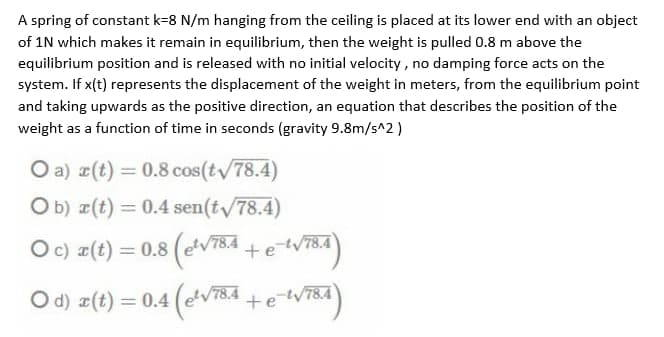A spring of constant k=8 N/m hanging from the ceiling is placed at its lower end with an object of 1N which makes it remain in equilibrium, then the weight is pulled 0.8 m above the equilibrium position and is released with no initial velocity, no damping force acts on the system. If x(t) represents the displacement of the weight in meters, from the equilibrium point and taking upwards as the positive direction, an equation that describes the position of the weight as a function of time in seconds (gravity 9.8m/s^2) O a) (t) = 0.8 cos(t/78.4) O b) z(t) = 0.4 sen(t/78.4) %3D O c) z(t) = 0.8 (eVT84 +e tv784) ot/78.4 %3D O d) z(t) = 0.4 (ev784 + e -t/78.4
A spring of constant k=8 N/m hanging from the ceiling is placed at its lower end with an object of 1N which makes it remain in equilibrium, then the weight is pulled 0.8 m above the equilibrium position and is released with no initial velocity, no damping force acts on the system. If x(t) represents the displacement of the weight in meters, from the equilibrium point and taking upwards as the positive direction, an equation that describes the position of the weight as a function of time in seconds (gravity 9.8m/s^2) O a) (t) = 0.8 cos(t/78.4) O b) z(t) = 0.4 sen(t/78.4) %3D O c) z(t) = 0.8 (eVT84 +e tv784) ot/78.4 %3D O d) z(t) = 0.4 (ev784 + e -t/78.4
Advanced Engineering Mathematics
10th Edition
ISBN:9780470458365
Author:Erwin Kreyszig
Publisher:Erwin Kreyszig
Chapter2: Second-order Linear Odes
Section: Chapter Questions
Problem 1RQ
Related questions
Question
Need this fast !

Transcribed Image Text:A spring of constant k=8 N/m hanging from the ceiling is placed at its lower end with an object
of 1N which makes it remain in equilibrium, then the weight is pulled 0.8 m above the
equilibrium position and is released with no initial velocity, no damping force acts on the
system. If x(t) represents the displacement of the weight in meters, from the equilibrium point
and taking upwards as the positive direction, an equation that describes the position of the
weight as a function of time in seconds (gravity 9.8m/s^2)
O a) r(t) = 0.8 cos(tv/78.4)
O b) r(t) = 0.4 sen(t/78.4)
Oc) a(t) = 0.8 (ev784-
= 0.8 (V784 + e tVT8a)
-t/78.4
%3D
O d) z(t) = 0.4 (eV78.4 +eW784
%3D
Expert Solution
This question has been solved!
Explore an expertly crafted, step-by-step solution for a thorough understanding of key concepts.
Step by step
Solved in 3 steps with 3 images

Recommended textbooks for you

Advanced Engineering Mathematics
Advanced Math
ISBN:
9780470458365
Author:
Erwin Kreyszig
Publisher:
Wiley, John & Sons, Incorporated

Numerical Methods for Engineers
Advanced Math
ISBN:
9780073397924
Author:
Steven C. Chapra Dr., Raymond P. Canale
Publisher:
McGraw-Hill Education

Introductory Mathematics for Engineering Applicat…
Advanced Math
ISBN:
9781118141809
Author:
Nathan Klingbeil
Publisher:
WILEY

Advanced Engineering Mathematics
Advanced Math
ISBN:
9780470458365
Author:
Erwin Kreyszig
Publisher:
Wiley, John & Sons, Incorporated

Numerical Methods for Engineers
Advanced Math
ISBN:
9780073397924
Author:
Steven C. Chapra Dr., Raymond P. Canale
Publisher:
McGraw-Hill Education

Introductory Mathematics for Engineering Applicat…
Advanced Math
ISBN:
9781118141809
Author:
Nathan Klingbeil
Publisher:
WILEY

Mathematics For Machine Technology
Advanced Math
ISBN:
9781337798310
Author:
Peterson, John.
Publisher:
Cengage Learning,

